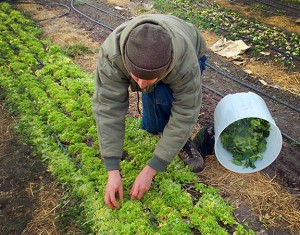
Sunday marked the last sugaring day of the season for this year, with a yield of a little over 800 gallons of sap, or about 16 gallons of syrup. This haul is pretty significant considering that our abbreviated sugaring season this year was a mere 2 weeks. The sap that flows now will be unsuitable for anything but drinking and potentially brewing. Despite the temperatures outside being perfect for sugaring, with the nights below freezing, and the day time temperatures mostly residing above, the silver maple trees have budded out, likely as the consequence of a string of lovely days that were a false prelude to spring. The intermittently singing chorus frogs have likely shaken their webbed fists at the sky in wonderment of these odd fluctuations.
Julie here, writing for you this week under the thumb of hopefully our final polar vortex. The bi-polar demonstrations from year to year in what to annually expect in reference to preparation for the season to come has so wildly shifted that I just don’t know what to think anymore. I am hoping that this week will be the last cold snap we experience, since I have been running low on wood for quite some time now. So many of us have had to scramble to find more fuel this winter as the result of record-breaking freezing temperatures, while other parts of the world such as Alaska and the Arctic were experiencing record highs. Times they are a-changing, and judging from how extreme these changes have been, I can only wonder at the probability that things will turn up in our favor.
Even so, Dan’s hoop-house is producing local greens by the bucket-load for us. I just finished eating a candy-sweet spinach salad that is unlike anything you could ever buy in a store, with the stems bursting with a surprising flavor that is incredible all on its own. If anyone tells you that all food is created equal, you are being misled— vegetables have such an array of flavors and nutrients based on the variety grown, and the medium it is grown in.
Unfortunately, the produce you find at the grocery store is neither grown for flavor or for nutrient content; it is grown based on maximum volume production, and its ability to survive a truck-ride across the country (and sometimes back again)! Broccoli now only has a quarter of the calcium it had in the 1950’s (and we all know how delicious calcium is!) A cup of this veggie used to have more calcium than a cup of milk, and now what we’re almost universally getting at the grocery store is a variety dubbed Marathon, likely because it is in a race to the bottom.
Or how about those poor excuses for oranges that you’ll find in the store these days; juiceless and tasteless! There are countless reasons to either buy from local farmer’s markets, or to grow heritage varieties in your yard if you have the space. I used to have a couple raised beds in the front yard of my urban home; whatever it takes for you to get the veggies YOU desire! If you’re more of a potato chip or French fry type of person, there’s nothing better than fries from potatoes you grew; I was on something of a sweet potato French fry bender a while back, because it’s so much easier to justify when you know where the food came from— they’re practically health food at that point, right?
It’s hard to believe that our first visitor session of the year is in three weeks! It hardly seems time yet, seemingly still frozen in the dead of winter, to share in the construction of our homes, digging of our gardens, and sharing of our lives, but there you have it. Visitors always bring an enthusiasm and vitality that reminds us that what we’re doing here is special, and unique. If you desire to visit Dancing Rabbit Ecovillage this year, please go to our website, and inquire about open slots for this season. We would love to have you join us in our 17th year of building sustainable community!
Dancing Rabbit Ecovillage is an intentional community and nonprofit outside Rutledge, in northeast Missouri, focused on demonstrating sustainable living possibilities. While we dream of spring, when tours will begin again, you can find out more about us by visiting our website, reading our blog, or emailing us.
